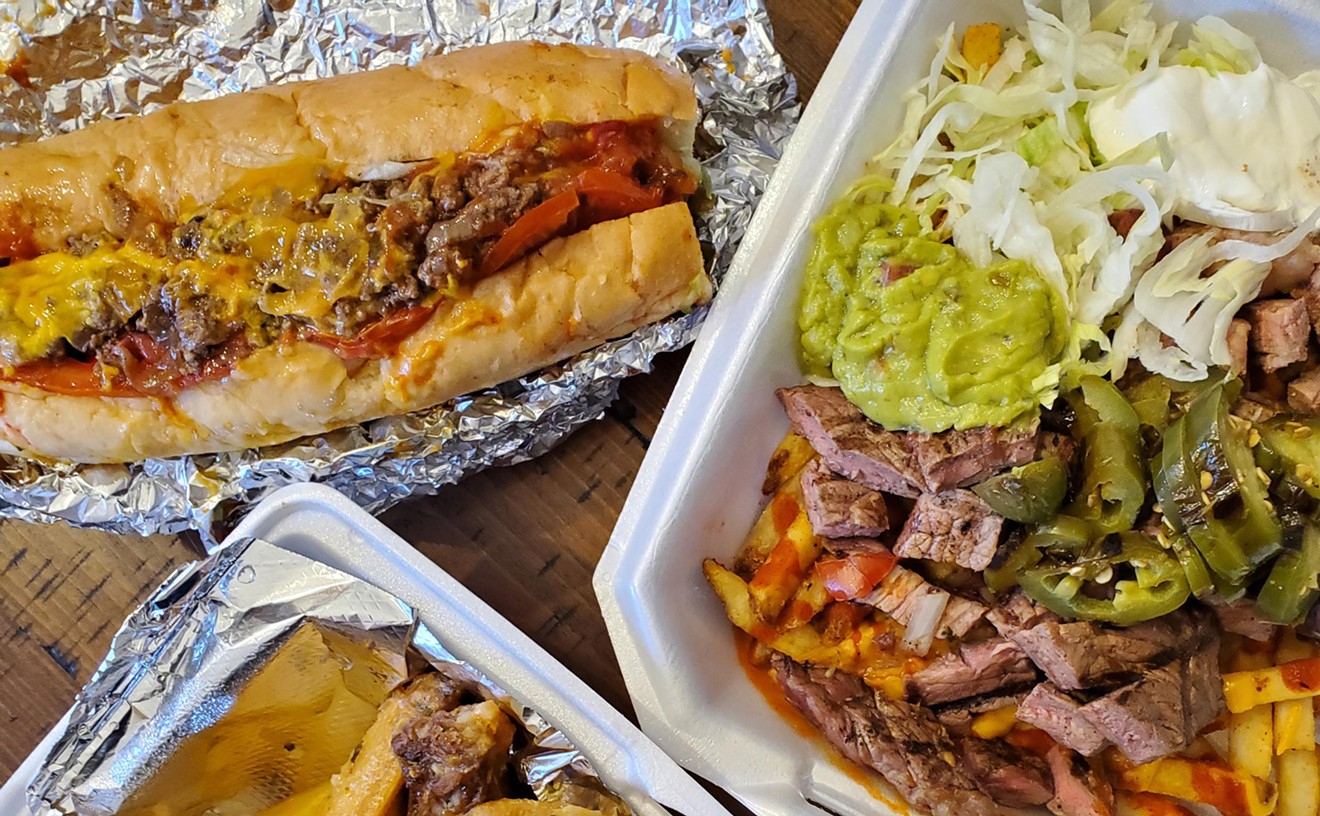This is part one of my interview with Ed Kammerer, exec chef-owner of Highland Pacific Restaurant & Oyster Bar; part two of our chat will run tomorrow.
If your kid is a picky eater, Ed Kammerer is here to give you hope. The exec chef-owner of Highland Pacific Restaurant & Oyster Bar wouldn't touch anything that came from the sea when he was a kid. In fact, when he tried a fresh clam for the first time, he couldn't stomach it, spewing the flesh and hanging his head in embarrassment. And it wasn't until much later in his career, while he was working the line at a restaurant in Carmel, California, that he faced an even bigger demon: the oyster. "I remember just staring at the oysters, wondering what to do, and being egged on by someone in the kitchen to try one," says Kammerer. But when he finally mustered up the courage, it was a revelation: "I ate it and my whole world changed, and then I just dived into seafood after that. My whole world just opened up."
Born in New Jersey and raised in Connecticut, Kammerer moved around quite a bit -- but he didn't begin to explore food possibilities (seafood aside) until his late teens. "I'd put stuff in my mouth, and everything just tasted so strong, so intense, but once I started working in a kitchen, things started to change," he says. That's when he was working on the line of an Italian restaurant, scraping burnt sauce from pots. But since pasta was one of the few things he'd eat, it worked out well, he says, and so did the gig, which convinced him that he had a natural talent for cooking.
After an early interest in architecture, he eventually got a degree in hotel and restaurant management and then enrolled in the accelerated culinary program at Johnson & Wales when the university still had a campus in Vail; Kammerer spent several years there in various kitchens, including Picasso, the highly acclaimed restaurant in the Lodge & Spa at Cordillera -- the same resort where Kobe Bryant ran into a bit of trouble. "Yeah, I was there when the whole Kobe Bryant thing went down," he says. "I got a phone call saying that I had to stay till midnight because a high-profile guest was coming in, and it turned out to be Kobe Bryant, who never did come in that night to eat dinner...." Bryant was otherwise engaged, as we know, and Kammerer says the resort went from a "secluded restaurant where you could get away from it all to a complete shit show of tabloid reporters and paparazzi, and everything just spiraled out of control." And that just wasn't his cup of java.
But while he never cooked for Bryant, he did cook for several celebrity chefs while working in a renowned restaurant in Carmel, where, along with discovering oysters, he shared space with French Laundry alums and had the opportunity to strut his skills at the 2000 Masters of Food and Wine event, which hosts some of the best chefs in the country. "The job was actually a bit of a demotion for me -- I was hired as a line cook -- but it was the best move I ever made, and when the Masters came, just watching all the chefs walking through the door was so amazing," he recollects, adding that he was Jacques Pépin's personal assistant for two days.
It was also a job that boosted his confidence and creativity, and when he eventually settled in Denver years later, he was ready to do his own thing. "My buddy, Brian Rockwell, who's my other partner at the restaurant, called me and said that he was watching a building in Highland getting renovated, and I came down and walked through the space and loved it," he says.
That restaurant -- Highland Pacific -- was initially going to sling sushi, reveals Kammerer, but there was already a raw-fish joint in the 'hood, so Kammerer took a few days to contemplate another concept, writing his ideas down on a napkin, and the next time he and Rockwell sat down to chat, they agreed that Highland was fishing for a seafood restaurant. "There wasn't a lot of seafood back in 2005, when we opened our place," says Kammerer, who'd become a dedicated fly fisherman. "And by then, I felt like I could take everything that I knew and learned and make a successful go of it in Denver. By then, I was no longer that picky kid."
In the following interview, Kammerer weighs in on inedible garnishes, properly seasoning your food and cell phones in the kitchen.
How do you describe your food? Coastal cuisine with Northeast, Gulf and Pacific Coast influences. As with a lot of chefs, it's derived from every place I've lived, worked and studied.
Ten words to describe you: Passionate, organized, creative, motivated, adventurous, respectful, craftsman, student, leader and American.
What are your ingredient obsessions? I've gone through a lot of ingredient obsessions throughout my career, and most of them come from being immersed in a particular region of the country for a period of time. But there are a few that have always stayed with me: bacon, truffles, potatoes, crustaceans, fresh herbs, bourbon, cream, olive oil, heirloom tomatoes, wild game, cheese and mushrooms.
What are your kitchen-tool obsessions? Knives are an obvious obsession of chefs, although my personal knives stay plastic-wrapped on a half-sheet pan in my kitchen when I'm not there. I'm very protective of them and the condition of the blade. I'm also very attached to my Vita-Prep blender, and I've carried a certain type of Crate & Barrel banquet spoon with me everywhere I've cooked for at least the last twelve years. This spoon has become a source of concern recently because they've discontinued the model I prefer.
Food trend you wish would go away: The trend that really bothers me seems to have disappeared -- large, inedible garnishes on dishes, like gigantic rosemary sprigs sticking out of mashed potatoes or tempura-coated shrimp heads topping pastas. I realize that they're technically edible, but they're not very practical, and certainly way more about shock value than speaking to the customer's palate.
Favorite local ingredient and where you get it: Heirloom tomatoes from Val Dahl's garden. She meticulously cares for the plants, and the flavors are outstanding. They're grown less than five miles from my restaurant, and they're always a focal point of my specials whenever she brings them in.
One food you detest: Rutabagas are on the top of that list. My mother used to cook them when I was a kid, and I always thought they tasted like burnt tires. I'm sure that they hold significant nutritional value, but I've never had them prepared in a manner that I thought was even close to edible.
One food you can't live without: It's tough to just pick one, but bacon would have to be at the top. It's rare that I'm designing a dish and can't figure out a way to use bacon to make it better. The pig truly is a magical animal.
Most memorable meal you've ever had: It was the fall of 2001, when I ate at the French Laundry. I was with five very good friends, one of whom was a chef du parties at the Laundry, and, needless to say, we got the full treatment. We had about fourteen courses, the most memorable being a foie gras course prepared six different ways, without one single ingredient being repeated other than the foie. The dinner and service was simply amazing, and the friends at the table made it even more special.
Favorite childhood food memory: I can't help but remember eating my first raw clam. My father took me to the world-famous Clam Broth House in Hoboken, New Jersey, and took me to a back-room bar area, where he told me only guys were allowed. This was back in the '70s, and there was a rule in Union County that women weren't allowed in the standing-room-only bar in the restaurant. My dad brought me in the bar, where the floor was completely covered in clamshells, while my mom and sister had to wait in the restaurant. My dad explained that when he was in college, he and his buddies would come here to eat clams and drink beer. Naturally, at about age nine, I wanted to be one of the boys, so I slurped one down -- a clam, that is -- and about two seconds later, it came right back up again. My dad just laughed, but I remember feeling like I had let him down. But it was so slimy and so bad that I couldn't see how it was remotely cool to eat these things. My dad finds it amusing that I now own a seafood-and-oyster bar.
Favorite junk food: I don't eat it much anymore, but I still love pork rinds -- spicy or regular flavor. I used to load up on these things -- and Dr Pepper -- in college for road trips. I mean, what could be better? Puffed, fried pork skins are absolutely delicious.
Weirdest customer request: A customer at the breakfast place I worked in Vail used to ask us to scoop out the bread part of her bagel and pack the skin with flavored cream cheese. It was like a bagel-skin taco with cream cheese in it. People are freaks in the morning about their food, which is why I don't cook breakfast anymore, except for immediate family and friends.
Weirdest thing you've ever eaten: I don't eat bugs -- that's just gross -- but I will eat almost anything else. I guess the weirdest thing I can think of would be corn smut, also known as huitlacoche. The chef that showed it to me referred to it as the Mexican truffle. It wasn't bad and tasted like a regular mushroom, but it looked disgusting.
What's always lurking in your refrigerator? Bacon fat, herb compound butter and crabmeat are pretty consistent things that I keep around, plus almond milk, hard-boiled eggs, lots of unusual cheeses and truffles, and there's foie in my freezer.
What's the difference between jam and jelly? I have been told the difference by one of my favorite bartenders in town, Samantha Chapman at Moe's BBQ, but I dare not tell you, because you couldn't print it. Go down to Moe's and order a Maker's shot and ask her: She'll gladly tell you the best answer to that question I've ever heard.
What question should I ask the next chef I interview? If you had to grab one piece of kitchen equipment to take with you into a steel-cage match to the death, what would it be, and how would you use it?
If you hadn't become a chef, what would you be doing right now? I'd probably be an architect or a musician. I originally went to college for architecture at Texas Tech University, and after a year and a half, I dropped it and changed to restaurant and hotel management. I really like designing things, and I went back to get my minor in architecture before I graduated. My other passion is music. I've got all the moves, and I can stay up and party all night with the best of them. I could have been a rock star if I could only carry a tune.
Follow @CafeWestword










